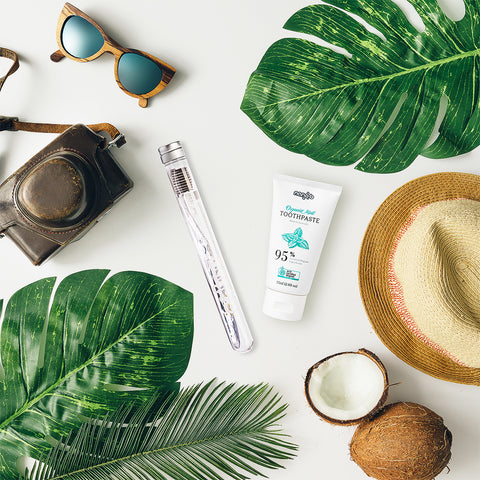What was the last time you checked the ingredients list on your toothpaste? While many people have developed the good habit of reading the labels on food items and some cosmetics, surprisingly, almost everyone neglects to do so for a personal care item like toothpaste.
As more and more studies show the strong connection between the health of your mouth and your overall wellbeing, it turns out what is in your toothpaste is as important as what is in the food you eat. So, let's dive into the world of toothpaste ingredients and see if there is any cause for concern.
We don't believe there are such things as good or bad ingredients. Ingredients are just a bunch of stuff mixed with other stuff, so we can get useful properties in the products we use. Unfortunately, the human body is a rather sensitive organism and it is easily affected by what it gets in contact with.
Companies make decisions ahead of scientific discoveries of the overall effect a specific ingredient might have on the human body in order to rush a product to the market, to cut down costs or because a specific ingredient is shown to have one positive property. Unfortunately, the holistic nature of the human body often means that even an ingredient with a proven positive effect in one aspect might pose a significant health danger in others.
If you haven’t read about how your oral and overall health is connected, please do. You will understand how toothpaste ingredients could enter your body, even if you spit most of it out.
It is very important for us as consumers to stay educated on both the positive and negative effects certain ingredients might have on our health, so we can make better decisions on what products to buy and use. We strongly recommend always reading the ingredients of all products you buy and have some basic knowledge on the effect some "controversial" ingredients might have on your body. With that being said, read below to find out the most controversial and potentially dangerous ingredients lurking in many conventional toothpaste brands.
Triclosan

Triclosan is an antibacterial chemical that has been shown to have some positive oral care properties. It is the ingredient most widely used by toothpaste brands that claim some "antibacterial" property. Unfortunately, this "positive" effect comes at a very steep price for your health. The chemical has been linked heavily to antibiotic resistance and endocrine disruption. It has been shown to interfere with hormones (especially estrogen and thyroid hormones), increase the risk of breast cancer, and reduce fertility (in man). In addition, triclosan has been shown to lead to the development of allergies (especially in children).
The chemical is also lipophilic. That means it stores itself inside fat cells in your body and can manifest itself in breast milk, urine, and blood. All of this can lead to long-term, chronic side effects.
The United States Environmental Protection Agency (EPA) classifies triclosan as a pesticide that puts both human health and the environment at risk. The European Union and the state of Minnesota have already banned triclosan in various products, but most states across the US still allow its use in toothpaste, hand soap, makeup, and other personal care products.
Even though triclosan has some antibacterial properties, the scientific evidence suggests the negative impact it has on your body is severe. There are many healthier alternatives to get the desired antibacterial effect from your toothpaste so, you definitely don't need this dangerous chemical in your everyday products.
Artificial Sweeteners and Dyes

Artificial sweeteners and colorants are among the most common toothpaste ingredients. As toothpaste became part of our everyday life, it was heavily marketed for its fresh and pleasant taste alongside its health benefits. As a result, people became accustomed to the common "sweet" taste and smooth consistency of most brands and their taste buds became familiar with this sensation.
Unfortunately, as most kinds of toothpaste are packed with chemicals (which don't taste and look nice at all), many artificial sweeteners and dyes are added, so the product is more marketable and looks and feels better to the mass customers. Needless to say, artificial sweeteners and dyes in your toothpaste have no positive health benefits whatsoever and many of them are shown to pose some danger to your overall health when used on a daily basis.
Artificial sweeteners have been shown to cause symptoms ranging from headaches and weight gain to more serious conditions like cardiovascular disease. Sorbitol and saccharin are among the most commonly used in toothpaste. Sorbitol has been shown to negatively affect people suffering from various gastrointestinal conditions, often resulting in severe abdominal pain. Other possible symptoms are flatulence and mild to severe diarrhea.
There are many natural and healthier alternatives that can be used and still enjoy a fresh and tasty toothpaste, so please keep a close look on the label when shopping. There are a few brands free of artificial sweeteners and dyes, so there are definitely healthier options available on the market. Of course, our favorite is the Nano-b Organic Mint Toothpaste :)
Propylene Glycol

Propylene Glycol is an active component used in antifreeze, paints, enamels and airplane de-icers. It serves as a wetting agent and surfactant in toothpaste. It not only feels weird to brush your teeth with something used in antifreeze and paints, it's also not particularly healthy.
The Material Safety Data Sheets for propylene glycol warn that the chemical can be rapidly absorbed through the skin, with prolonged contact leading to brain, liver and kidney abnormalities. The EPA forbids its workers to handle propylene glycol without wearing rubber gloves, yet humans have direct contact with it through common health care and cosmetic products.
There is a lack of extensive data research on the exact effect of propylene glycol on humans, but it is widely recognized as a skin, eye and lung irritant and it’s linked to organ system toxicity. Again, it doesn't add any health benefits to your toothpaste, so you are not losing on any important health properties when you avoid it.
Sodium Lauryl Sulfate (SLS)

Surfactants are the chemicals used to create foam when brushing your teeth. The truth is you don't really need your toothpaste to foam, as this has absolutely no positive effect for your brushing experience. This is just another thing we are used to and another marketing trick that was installed in our brains to make us feel the toothpaste is "working".
Unfortunately, SLS, which is the most widely used surfactant in toothpaste, interferes with the functioning of our taste buds by breaking up the phospholipids on the tongue. That’s supposed to be the main reason behind the bad taste of food after we brush our teeth in the morning.
However, the bad food taste is not the only cause for concern. According to the American College of Toxicology, SLS may linger within the body for up to five days, accumulating in the heart, liver, lungs, and brain. When combined with certain other chemicals, it becomes nitrosamines, a class of powerful carcinogens that provoke the body to absorb harmful nitrates. There are also concerns that SLS can lead to damaged eyes, irritated skin and labored breathing.
SLS also has a huge negative impact on our environment. The manufacturing process of SLS releases carcinogenic volatile organic compounds into the environment. It is listed as an insecticide and could be toxic to marine life.
It's crucial to be educated as consumers that excessive foaming is just a marketing trick and not something we need in our personal care products. SLS is the main culprit here and it's within our power as consumers to keep a close eye on the labels and look for SLS-free options.
Diethanolamine (DEA)

Here are some scary facts: The Environmental Working Group (EWG) ranks DEA as number 10 (the most toxic score) in its cosmetic ingredients database, due to high concerns of organ system toxicity, contamination concerns, and irritation, along with moderate cancer risk. The California Environmental Protection Agency states that DEA is a possible carcinogen for humans and other mammals.
Diethanolamine (DEA) is another foaming product commonly used in toothpaste. However, it also has well-documented health risks. According to a report from the Environmental Working Group, DEA is linked with stomach cancer, bladder cancer, liver cancer, and organ system toxicity. It is easily absorbed through skin tissue such as your gums and tongue.
DEA disrupts hormones and can react with other ingredients to create a potential carcinogen - NDEA (nitroso diethylamine). Dr. Samuel Epstein, professor of environmental health at the University of Illinois, warns that if the skin is repeatedly exposed to DEA, it can lead to increased risk of liver and kidney cancers. Various studies also show that it could cause cancer to the stomach, esophagus, liver, and bladder.
These are too many health risks for an ingredient that has absolutely place in your personal care products, especially in your toothpaste. Luckily, recently many brands have eliminated DEA from their formulas, however, please check labels carefully as there are still some brands that use it.
Fluoride

Fluoride is as controversial as a toothpaste ingredient can get. The reason is that for many years there were many people in both camps (including dental professionals) that defended or stigmatized fluoride.
There is a general consensus among dental professionals that fluoride has positive oral health properties. As a mineral, fluoride occurs naturally in many foods and water and is a vital element for the remineralizing process of the teeth. Not many people would argue that remineralization is a crucial process for proper oral health and fluoride is among the main minerals supporting this process.
However, fluoride opponents have two major objections. First, many people claim that while it is indeed an important mineral for remineralization, taking it with your toothpaste is far from optimal. Different studies report the thickness of the fluoride layer formed on your teeth after brushing is a mere 6 nanometers thick, which is considered rather insufficient for any meaningful remineralizing effect.
Second, many people oppose fluoride for its toxic properties. It is perceived as the main culprit behind dental fluorosis, which is a dangerous condition, especially in children (hence, all the warning signs that children should be supervised when brushing their teeth with a fluoride toothpaste as they tend to swallow more of it.)
When adults brush their teeth they also don’t spit all of it and as we have explained in another article - many elements could enter our body through the mouth, not only if swallowed. The main problem here is the toxic nature of fluoride and its tendency to accumulate in the body over time, which has been linked to endocrine dysfunction, neurological problems and brain and kidney issues.
It's important to realize that while fluoride is indeed a vital mineral for healthy teeth, you don't need to source it through your toothpaste (which is not even a reliable sources as all the controversy suggests). Fluoride occurs naturally in many foods and water, so a balanced diet will most likely guarantee sufficient fluoride intake. Of course, you may always consult your dentist whether you need additional ways to remineralize your teeth, but for most people fluoride in toothpaste in unnecessary exposure to a toxic ingredient.
Other ingredients you should look out for
Here’s is an additional list of common toothpaste ingredients that you should watch out for. Keep in mind none of the following ingredients have any important beneficial effect on your oral health, while there is enough controversy around them to suggest you are better off avoiding them in your toothpaste.
Titanium Dioxide is a white coloring agent, used to get the well-known white color of most toothpaste brands. Unfortunately, it is listed as a possible cancerogenic and could weaken the immune system.
Carrageenan acts as a thickener and it was until recently considered a safe natural ingredient because it comes from red algae or seaweed. However, the National Organics Standards Board voted in November 2016 to remove carrageenan from the list of substances allowed in organic food. There is some evidence suggesting that it can lead to inflammation, digestive troubles, skin rashes and is a possible cancerogenic.
Parabens are mostly used in toothpaste as preservatives. The bad news is these compounds mimic the hormone estrogen and estrogen disruptors have been linked to breast cancer and reproductive issues. As a result, scientists recommend limited use of parabens in cosmetics.
Tetrasodium (Tetrapotassium) Pyrophosphate is an ingredient that is used to keep calcium phosphate salts (tartar, or calculus) from fossilizing on the back of your lower front teeth. A potential problem with tartar control types of toothpaste is that in order for the active ingredient to work, it has to be dissolved in a strong detergent, which can have a negative impact on people that are sensitive to high pH.
How to choose a safe toothpaste?

The first and most important step is to always read the ingredients list and label information. Now, that you know the most controversial and potentially dangerous ingredients it's much easier to avoid them. If you see an ingredient you are not sure about, a quick search online will give you at least some basic information on how safe the ingredient is.
It's true that there is a lot of controversy around when it comes to the health benefits and dangers posed by different ingredients. The saying that "everything we eat both causes and cures cancer" is not far from the truth. The problem is that sufficient research is lacking for many of the ingredients in question and it becomes virtually impossible to make a completely educated decision with perfect information.
At the end of the day, it comes down to our values and beliefs and the choices we make for ourselves. At Nano-b, we strongly believe we don’t have to gamble with our health every time we brush our teeth. We are all better off when we stay as close to nature as possible and this is the principle we followed when we developed the Nano-b toothpaste, a completely natural and organic toothpaste, free of all the nasty stuff mentioned in this post.
Happy brushing!
Team Nano-b




Comments (0)
There are no comments for this article. Be the first one to leave a message!